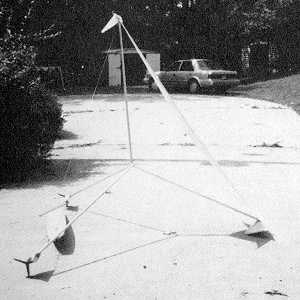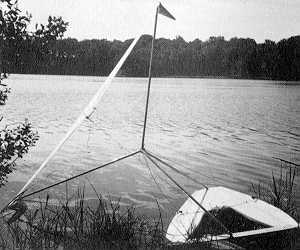Mr Smith's Amazing Sailboats
The Fliptackers
(Section 4 of 6)
Initial Fliptacker Designs
In 1982, after seemingly having finished with his high-speed
sailboat experiments, Bernard Smith came up with a new approach to designing the
"perfect" hydrofoil sailboat. Around this time, Ralph Gitomer met Bernard
and the two collaborated on testing this new concept. Bernard's design consisted of
the now familiar tetrahedral framework, made up of two pairs of tubes. A small
low-drag hull was placed between the endpoints of one pair of tubing, and a stretched
fabric sail was arranged between the other pair. Small tip foils were placed by the
ends of the sail and attached to the framework. Two sets of lifting foils were also
attached to the framework, located fore-and-aft of the hull. These foils were
"bifurcated" or split to ensure that they worked equally well on either
tack. The design was dubbed the "Fliptacker" for obvious reasons.

The new configuration seemed to combine all
the advantages of the Aerohydrofoil's foil arrangement but did away with the performance
limitations created by the proa layout - where the foils had to operate in both
directions. Now the performance offered by conventional foil designs could be fully
exploited. Working exclusively with models, Bernard's Fliptackers did well, proving
to be fast and controllable, though on no account could they be made to actually tack.
Split-Hull Fliptackers
In an effort to make the configuration capable of tacking,
Bernard tried another approach. He did away with the windward foils and hull, etc
and replaced them with a "split hull" - two lightweight hulls joined together at
an angle of 30°. The framework, containing the sail and tip foils, were hinged to
it. When sailing, only the leeward hull was actually in the water.

The logic of this design centered around having minimal
drag on the sail when the framework rotated from side-to-side during the tacking
maneuver. At the midpoint of the tacking manouver, the sail itself would
ideally be parallel to the wind (0° & at lowest drag). But imagine if the sail
was fixed to the framework at an angle of 15°, then in order for the sail to be at 0° at
the midpoint of tacking, it would need to change through 15° of pitch. Skewing the
framework by 15° off the centerline of a hull would achieve this. Using the
split-hull arrangement allowed the framework to be "skewed" on either
tack. Clever but strange.
The (free-sailing) models weren't perfect, although the much sought after tacking ability
appeared closer to occurring. The models weren't as directionally stable as
the foiled Fliptackers, but it seemed that a crewed version of the Split-hull Fliptackers
would overcome any difficulties with steering and tacking, simply because of the sailor's
ability to actively control the craft. A piloted craft seemed the next step.
Super Boardsailor Fliptackers
Using the Split-Hull Fliptacker model as their starting point,
Bernard Smith and Ralph Gitomer now planned and detailed a manned version. Taken
with the success of the sailboard, both in terms of its popularity and its speed
potential, this new design was hoped to be one step along the evolutionary chain from the
sailboard.
With the prospect of having a full-sized and manufacturable device on the market, it
appears that quite some attention was given to making it a practical craft to handle.
Some of the new features the design incorporated included:
- Tip foils that yielded when the craft's caught aback - so making handling the craft
safer.
- A tetrahedral framework with a unique center joint, allowing the rig to collapse down
for easy disassembly and transportation.
- A collapsible split-hull arrangement allowing the hulls to be arranged closely enough
for them to be car-transportable.
- A multi-section sail that can change sail area whilst remaining in tension.

A 4-ft model fitted with the collapsible hulls
is shown above. After Ralph's and Bernard's work developing the Super
Boardsailor Fliptacker concept, a patent was granted (see the Resources section), though
it appears no actual full-sized version was made.
It was around this time, 1989, that Bernard's second book, "Sailloons and
Fliptackers" was published, detailing the major developmental work that had taken
place subsequent to his 1963 tome, "The 40-knot Sailboat". Ralph Gitomer
went on to develop his own manned versions of the Fliptacker - more details can be found
in the section titled "Other
Craft". Bernard concentrated on the Fliptacker models - returning to the
original hydrofoiled concept. This is detailed in the "Mini-Fliptackers" section.